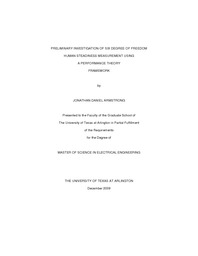
ATTENTION: The works hosted here are being migrated to a new repository that will consolidate resources, improve discoverability, and better show UTA's research impact on the global community. We will update authors as the migration progresses. Please see MavMatrix for more information.
Show simple item record
| dc.contributor.author | Armstrong, Jonathan Daniel | en_US |
| dc.date.accessioned | 2010-03-03T23:30:40Z | |
| dc.date.available | 2010-03-03T23:30:40Z | |
| dc.date.issued | 2010-03-03T23:30:40Z | |
| dc.date.submitted | January 2009 | en_US |
| dc.identifier.other | DISS-10490 | en_US |
| dc.identifier.uri | http://hdl.handle.net/10106/2053 | |
| dc.description.abstract | Tremor is an undesired oscillatory movement of a body segment which limits a person's ability to accomplish tasks. A conceptually sound, single number measure reflecting steadiness (defined as the inverse of tremor) of body segment is desired. Technology has advanced to make six degree of freedom (DOF) characterization of motion feasible, but the challenge remains regarding how to process time series data from multiple DOFs to achieve the single number composite measure. Previous conceptual work has applied General Systems Performance Theory (GSPT) to this problem. This thesis reports the investigation of steadiness composite measure formation. Three composite formation candidates were identified (simple average, vector-based, and GSPT-based). Simple average (i.e., employing addition of component measures) and GSPT-based approaches were extensively evaluated conceptually and experimentally. Conceptually, GSPT-based composites exhibited predictive validity in simple engineering-like decision-making tasks, whereas the simple average composite failed and provided misleading interpretations. The GSPT-based composite was shown to be intrinsically more sensitive than the simple average method. In addition, simple average and other addition-based methods were shown to have a major conceptual flaw associated with summing of quantities with different units. For the experimental aspects, six DOF inertial data was collected from subjects (n = 26) with a newly developed Steadiness Measurement Device (SMD) affixed to their hand. Subjects executed a series of 15s test tasks (maintain maximal steadiness and simulation of selected possible pathologic tremor). The maximal steadiness test was executed twice in order to determine short-term reliability. Translational acceleration and angular velocity signals were processed to obtain intermediate displacement time series records that were further processed to yield single number steadiness capacity measures for each DOF. These were then combined using the candidate composite formation methods under evaluation. The GSPT-based composite showed superior discriminating ability between simulated pathologic and healthy tremor motion as evidenced by high sensitivity (ratio of most steady to least steady subject, on the order of 2x10^14:1). It also exhibited the best test/retest reliability (Pearson r = 0.786) of all considered test cases and was comparable to previous results reported for similar test subject characteristics.It is concluded that GSPT-based composite steadiness measures (mm^-3deg^-3) are the best option for truly representing the concept of hand (or other body segment) steadiness. The resultant orders of magnitude difference in GSPT-based measures between pathologic and healthy tremor cases is believed to shed new light on explaining the vast difference in performance observed between individuals. Ultimately, this thesis lays the foundation for additional work in defining a standard approach to body segment steadiness measurement and characterization. | en_US |
| dc.description.sponsorship | Kondraske, George | en_US |
| dc.language.iso | EN | en_US |
| dc.publisher | Electrical Engineering | en_US |
| dc.title | Preliminary Investigation Of Six Degree Of Freedom Human Steadiness Measurement Using A Performance Theory Framework | en_US |
| dc.type | M.S. | en_US |
| dc.contributor.committeeChair | Kondraske, George | en_US |
| dc.degree.department | Electrical Engineering | en_US |
| dc.degree.discipline | Electrical Engineering | en_US |
| dc.degree.grantor | University of Texas at Arlington | en_US |
| dc.degree.level | masters | en_US |
| dc.degree.name | M.S. | en_US |
| dc.identifier.externalLink | https://www.uta.edu/ra/real/editprofile.php?onlyview=1&pid=219 | |
| dc.identifier.externalLinkDescription | Link to Research Profiles | |
Files in this item
- Name:
- Armstrong_uta_2502M_10490.pdf
- Size:
- 3.790Mb
- Format:
- PDF
This item appears in the following Collection(s)
Show simple item record


